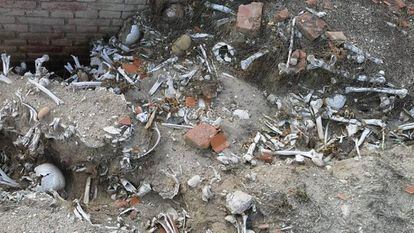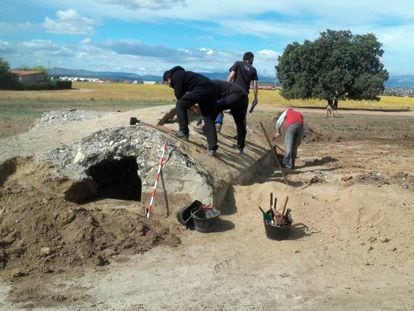How heavy rains uncovered Franco’s lost victims in Madrid’s biggest cemetery
A mass grave that is thought to contain the remains of as many as 3,000 people who were executed after the Civil War has been revealed in La Almudena graveyard

The remains of 3,000 people executed in Madrid by Francoist military courts between between April 1939 and February 1944 have been discovered in the city’s massive La Almudena cemetery, much to the surprise of historians and family members who believed the remains had been cremated. The mass grave was found last year after heavy rains eroded the dirt and exposed the bones.
The remains of the executed Republicans were most likely buried along with the bodies of thousands of ordinary citizens
Work carried out by City Hall’s Human Rights and Historical Memory department, as well as the municipal Funeral Service company, suggests that the discovery is one of La Almudena’s ossuaries, in which the remains of the executed Republicans were most likely buried along with the bodies of thousands of ordinary citizens who died of reasons unrelated to the Spanish Civil War (1936-39) and the subsequent dictatorship of General Francisco Franco.
The finding disproves long-standing claims by the municipal funeral company that the executed Republicans had been exhumed from their tombs in the 1990s and incinerated in the crematorium at Madrid’s Carabanchel cemetery. This version of events was trusted for years by historians, family members and the group Memoria y Libertad (Memory and Liberty), an association that aims to share data and information on the victims of the Francoist regime with family members.
It was a genuine surprise, because it was thought that the ossuary was empty
Mauricio Valiente, Madrid City Hall
“It was a genuine surprise, because it was thought that the ossuary was empty,” explains Mauricio Valiente, the third deputy mayor of Madrid City Hall and the head of the Human Rights and Historical Memory department. “We are in the process of hiring a specialized company to survey the grave and determine its dimensions and the number of bodies,” he adds. “The resulting report will also help us date the remains.”
Despite the discovery, Valiente doesn’t believe that the victims will be able to be identified. “Whatever happens, this space must be dignified out of respect for the family members. They are about to start a process in La Almudena of building a memorial to commemorate the victims.”
Francisco Exteberria, a forensic anthropologist, visited the grave a few months ago to try to gather more information on it. “I inspected the grave, which seems very large and whose depths are unknown. It’s a classically conceived ossuary, which were designed so that the organic material would dry out and decompose in the fresh air,” he explains.
The grave is located in an area that is off limits to the public and is within the original boundaries of the cemetery, which was expanded in 1955. Gabino Abánades, the former manager of the Madrid Cemeteries company, says that not one but two mass graves containing the remains of Franco’s victims from the post-Civil War era – including those of the so-called “Thirteen Roses” – exist in La Almudena. “The graves that were exhumed and cremated in the Carabanchel cemetery were from after 1955,” says Abánades, who worked at La Almudena for 46 years. For this reason, he says, it is not hard to identify the grave that was just recently discovered, which may contain the remains of up to 50,000 people. “Everything is detailed in the cemetery’s archives,” he adds.
The poor conditions in which the remains were found will make it very difficult to identify the remains
However, this claim is refuted by historian Fernando Hernández Holgado, a professor at the Madrid Complutense University and the director of a multidisciplinary team that, at the request of City Hall, has investigated the people who were executed between April 1939 and February 1944 in Madrid. This study will form the basis for the memorial to the victims that will soon be built in La Almudena. Hernández Holgado has been able to verify that 2,933 people were executed in this period, the majority of whom were shot against the walls, or in the vicinity, of La Almudena. “There is no documentation about this,” he claims. “We always thought that the remains had been cremated.”
According to Francisco Etxeberria, the poor conditions in which the remains were found will make it very difficult to identify the remains, despite the fact that the people executed had a lead identification tag hung around them. A determining factor will be the discovery of skulls with bullet wounds, indicating that they had been shot at close range, he explains.
English version by Asia London Palomba.












































